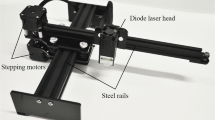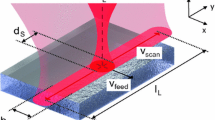Abstract
The CO2 laser ablation is a common technique for patterning the microchannels and holes used in microfluidic devices. However, the ablation process frequently results in an accumulation of resolidified material around the rims of the ablated features and a clogging of the base of the microchannel. In the article, these problems are resolved by means of a proposed metal-film-protected CO2 laser ablation technique. In the approach, the substrate is patterned with a thin metallic mask prior to the ablation process and the mask is then stripped away once the ablation process is complete. The feasibility of the proposed approach is demonstrated by fabricating two micromixers with Y-shaped and T-shaped microchannels, respectively. It shows that for a designed channel width of 100 μm, the metallic mask reduces the ablated channel width from 268 to 103 μm. Moreover, the bulge height around the rims of the channel is reduced from 8.3 to <0.2 μm. Finally, the metallic mask also prevents clogging in the intersection regions of the two devices. The experimental mixing results obtained using red and green pigment dyes confirm the practical feasibility of the proposed approach.






Similar content being viewed by others
References
Chen Y, Zhang L, Chen G (2008) Fabrication, modification, and application of poly(methyl methacrylate) microfluidic chips. Electrophoresis 29:1801–1814
Cheng JY, Wei CW, Hsu KH, Young TH (2004) Direct-write laser micromachining and universal surface modification of PMMA for device development. Sens Actuators B 99:186–196
Chung CK, Lin SL (2011) On the fabrication of minimizing bulges and reducing the feature dimensions of microchannels using novel CO2 laser micromachining. J Micromech Microeng 21:065023
Chung CK, Shih TR (2007) A rhombic micromixer with asymmetrical flow for enhancing mixing. J Micromech Microeng 17:2495–2504
Gerlach A, Knebel G, Guber AE, Heckele M, Herrmann D, Muslija A, Sshaller TH (2002) Microfabrication of single-use plastic microfluidic devices for high-throughput screening and DNA analysis. Microsyst Technol 7:265–268
Huang YG, Liu SB, Yang W, Yu CX (2010) Surface roughness analysis and improvement of PMMA-based microfluidic chip chambers by CO2 laser cutting. Appl Surf Sci 256:1675–1678
Huikko K, Kostiainen R, Kotiaho T (2003) Introduction to micro-analytical systems: bioanalytical and pharmaceutical applications. Eur J Pharm Sci 20:149–171
Jensen MF, Noerholm M, Christensen LH, Geschke O (2003) Microstructure fabrication with a CO2 laser system: characterization and fabrication of cavities produced by raster scanning of the laser beam. Lab Chip 3:302–307
Liang L, Ai Y, Zhu J, Qian S, Xuan X (2010) Wall-induced lateral migration in particle electrophoresis through a rectangular microchannel. J Colloid Interface Sci 347:142–146
Pemg BY, Wu CW, Shen YK, Lin Y (2010) Microfluidic chip fabrication using hot embossing and thermal bonding of COP. Polym Adv Technol 21:457–466
Reotting O, Ropke W, Becker H, Gartner C (2002) Polymer microfabrication technologies. Microsyst Technol 8:32–36
Wang ZK, Zheng HY, Lim RYH, Wang ZF, Lam YC (2011) Improving surface smoothness of laser-fabricated microchannels for microfluidic application. J Micromech Microeng 21:095008
Acknowledgments
This work is partial sponsored by National Science Council (NSC) under contract No. NSC 99-2221-E-006-032-MY3 and NSC 102-2221-E-006-040-MY3.
Author information
Authors and Affiliations
Corresponding author
Rights and permissions
About this article
Cite this article
Chung, C.K., Tu, K.Z. Application of metal film protection to microfluidic chip fabrication using CO2 laser ablation. Microsyst Technol 20, 1987–1992 (2014). https://doi.org/10.1007/s00542-013-2041-3
Received:
Accepted:
Published:
Issue Date:
DOI: https://doi.org/10.1007/s00542-013-2041-3




